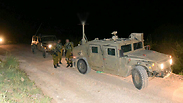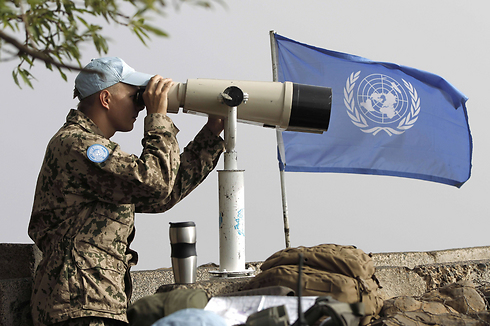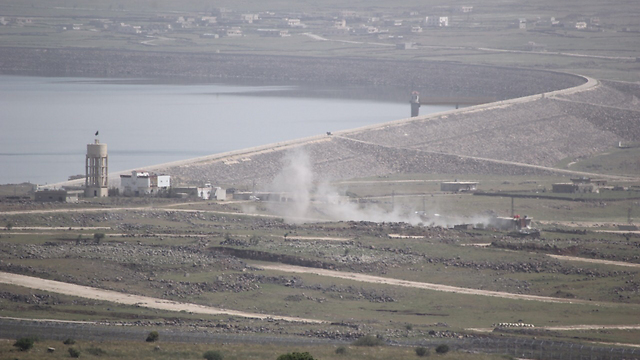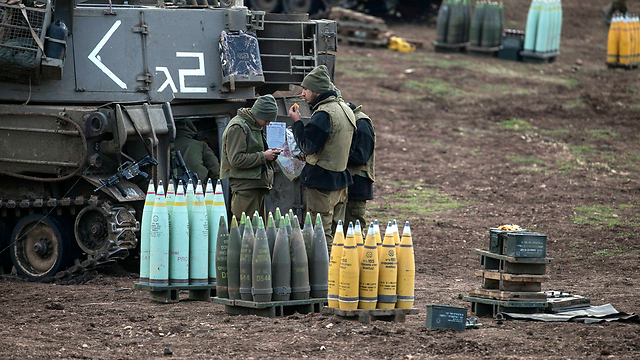
A battle of wits on the Syrian border
Analysis: Israel has a new defense policy on the Golan Heights, where Islamist groups are taking hold and Hezbollah divides its time between fighting them and fighting Israel.
On a hill at the foot of Mount Hermon, a bomb disposal team from the United Nations was hard at work last Tuesday morning. UN men clad in camouflage and blue helmets slowly guided a sapper in a heavy protective suit toward four bodies lying on the terrace below.
The bundle of explosives carried by one of the terrorists was clearly visible in the thick green grass of early spring. The four had a few nights earlier attempted to lay explosives intended for IDF soldiers, but Israeli troops saw them cross the cease-fire line and begin laying charges some 150 meters below the abandoned bunkers of an old IDF post.
The area is undisputedly Israeli, but the new barrier fence was established along a new route that is more convenient and set further back, and does not block access to Syria. IAF jets dispatched to the area fired several precision missiles that thwarted the attack and took out the perpetrators.
It turned out that the terrorists were local Druze men with links to Hezbollah, who were likely operating on its orders. Their real identities were revealed by the mourners' tents set up in the Druze town of Majdal Shams, not far from the Syrian village of Khadr, on the other side of the border.
Most of Khadr's villagers are loyal to the Assad regime, fighting alongside it and regularly collaborating with Hezbollah representatives in the region. At least one member of the foursome taken out on Sunday had already placed explosives at the same site a year ago - almost on the same rock. Then, too, Hezbollah was on a mission to settle accounts with the IDF.
Last year's bomb exploded, wounding an officer and a paratrooper who were on patrol in the area. This time, the attack was foiled. It was most likely supposed to be retaliation by the radical Shiite axis (Hezbollah-Iran-Syria) for air strikes in Syria, which targeted a convoy of missiles destined for Hezbollah in Lebanon. The Arab media attributed the attack to Israel. Hezbollah probably did too.
The IDF did not rush to remove the bodies from the area despite the unrest that was beginning to brew in the local Druze villages - Majdal Shams on the Israeli side and of course Khadr in Syria. The families of the terrorists demanded that the bodies of their sons be brought for burial, but in the same breath claimed that the four had not been planning any attack and that Israel "killed" them unfairly. Finally, the IDF consented - as a gesture to the Druze in Israel – to the terrorists' families receiving the bodies.
Israel has a vested interest in using the incident for political leverage. UNDOF (United Nations Disengagement Observer Force) personnel were invited to document the bodies and see their explosives up close. In other words, to see that this was a foiled attempt to attack Israeli territory. Moreover, the attempted attack was carried out just 350 meters from a UNDOF post, right under the noses of the Irish battalion stationed there.
It was nighttime, but had the UN officers picked up their binoculars, they would have seen the four heading for their destination.
Israel was keen to emphasize this fact too. Indeed, once the UNDOF men had finished their work on the ground, Israeli Ambassador to the UN Ron Prosor on the same day filed a complaint to the Security Council about a Syrian violation of the ceasefire agreement.
This complaint has no immediate practical significance, but if one day Hezbollah and its allies begin firing into Israel - and the IDF takes military action in Syria and Lebanon - these accumulated complaints at the Security Council will constitute proof that it was an act of self-defense after a long period of restraint on the part of Israel.
After the UN finished its documentation at the scene, the IDF responded to the wishes of the Druze dignitaries and allowed residents of Khadr to collect the bodies of their sons. This is good for deterrence, and helps preserve the relationship based on mutual good will in the Druze community on both sides of the Golan Heights border fence. Those hostile to Israel today may not always be so in the future.
Cabins and mortars
And while UN officials were cautiously approaching the terrorists' bodies, the sirens began to wail in nearby Majdal Shams. The alert sounded too in Druze villages and Jewish communities across the northern Golan and the Galilee. Then it turned out to be a false alarm. Mostly.
Mortar shells fired from Syrian territory had exploded inside Israel, in the orchards of Kibbutz Ein Zivan. There were no casualties or damage, but some feared that this was Syrian or Hezbollah retaliation to compensate for the bungled attack, and – to be on the safe side - pushed a few unnecessary buttons in the war room of the Home Front Command.
Then it turned out that it was the Syrian rebels misfiring mortars into Israel. After expelling the Syrian army and Hezbollah from the Golan Heights, the rebel groups are now fighting each other for control and honor. Some of the battles take place right next to the ceasefire line on the Golan Heights border. That same morning and throughout Tuesday, Israel observed heavy exchanges of fire in the Quneitra area between the Al-Nusra Front, which controls most of the Syrian side of the Golan, and those loyal to Islamic State.
Both sides are using all means at their disposal - pickup trucks with heavy machine guns, mortars and even a tank seized from the Syrian army. "Our livelihood has gone," says Hana, as she looks out at the colorful spring scenery from the dining room windows of Kibbutz Merom Golan. "No one will come to see this beauty or pick cherries in May, with all these booms."
For now, the holiday cabins enjoy good occupancy at weekends, and residents of the Golan Heights are making a good living from tourism, wine and asado (Argentine-style steak), but every security incident does have an immediate impact on tourism.
A senior commander in the area said explicitly that one of the considerations of the IDF restraint in response to such incidents.
"We must provide local residents with not just security, but also a sense of security, and not only for residents, but also for the tourists; so we avoid a possible escalation, particularly if it does not serve as military deterrence."
This sentence embodies the new Israeli defense doctrine on the Golan. From the moment the Syrian army and the Assad regime loyalists lost most of the Syrian Golan, there was no one to deter. The area is dominated by "fifty shades of black," says a very senior IDF officer on the northern front.
It's not just a metaphor. The color black is used on maps and computer screens to denote villages and areas controlled by Islamist groups tied to global jihad. In particular groups linked to the Al-Nusra Front or those who have recently declared their allegiance to Islamic State.
Green indicates the rebel groups aligned to the secular Free Syrian Army or the "Islamists lite" (mainly the Muslim Brotherhood). Red is for what is left under the control of the Syrian regime army, Hezbollah and the "homeland defense committee" militias (the heirs to the vicious Shabiha of the Assad regime) that operate under the direction of Hezbollah.
The map of the Syrian Golan Heights was recently covered in black, denoting the dozens of Islamist groups, each with its own agenda and ideology, fighting one another. In most communities there is coexistence among the groups, until they decide to fight each other all over again.
About two months ago, the radical Shiite axis – the Syrian army, Hezbollah and advisers from the Iranian Revolutionary Guards – launched a major offensive to block the passage of the rebels between the area of the Jordanian border and Damascus. At the same time, the axis tried to regain control of the Golan Heights. The plan failed, and the Syrian army's presence in the Golan is reduced to the Shouting Hill opposite Majdal Shams and in the form of 100 Hezbollah fighters defending new Quneitra against attacks by the al-Nusra Front.
Gloomy forecast
All of these sparked a recent dramatic change in the security situation on both sides of the ceasefire line on the Golan Heights. Aspects of the new situation were clearly visible during my recent tour of the area.
Firstly, the radical Shiite axis led by Hezbollah has transformed the Golan Heights into an active front against Israel. Hezbollah, the Syrian army and militias loyal to the Assad regime are now focused on two things: stopping the rebels' advance on Damascus and a secret offensive, without clear fingerprints, against Israel.
Attacks against the IDF on the Golan using local emissaries (mostly Druze or Palestinian) allow Hezbollah and the Iranians to exact revenge and harass Israel without getting directly involved, and without endangering the people of Lebanon or the vast arsenals of Iranian-supplied missiles stored there. For the radical Shiite axis, the Golan Heights is now an "deniable zone" that it can attack, causing harm to Israeli tourism while remaining quiet or even claiming that it never happened. A lack of governance gives the advantage to those willing and able to seize it.
The second component is the rebel takeover of the Golan Heights, forcing Assad loyalists and the Shiite axis to the northern corner of the territory. This is the seemingly good news. The bad news is that the dominant forces in the area are Jihadist groups such as Al-Nusra Front, "Shuhada Al Yarmuk" (Islamic State loyalists who control the southern Golan Heights), and Saraya al-Jihad (the Jihad Brigades), to the Salafist group near Quneitra. The "moderate" rebels, mainly members of the district who want to stay alive and earn a living, are weak and have been dominated by those who earn a black mark on the map.
This is a gloomy outlook for the future. In fact, the situation on the Golan is a realization of what everyone believes will happen in Syria if and when the Assad regime collapses. It is thought that what will follow will be a bloody war between the rebel groups over the spoils. This is just what happened in Afghanistan, where the fighting has continued in varying degrees of intensity for more than 20 years. On the Golan, it is already happening.
What is interesting is that all of the rebel groups, including the extremist ones, prefer to place their bases and headquarters several hundred meters from the border fence with Israel. So the villagers fleeing their homes because of the fighting set up tents where there is a prominent IDF presence. There, they are safe, as regime forces will not bombard them from the ground nor bomb them from the air with warplanes or with helicopters delivering deadly barrel bombs.
They also noticed that the Syrian army has learned the hard way that Israel does not restrain its fire during infiltrations into its territory. As such, the extremists among the rebels have no interest in to disturb the calm on the Israeli Golan or even in the "shelter zone" along the border fence. The jihadist rebels might in the distant future turn their weapons on Israel, like they did in Sinai. But for now they have more than one good reason to refrain from doing so.
New challenges
As a result of these developments - in fact as a result of a correct assessment that these developments would take place sooner or later - the IDF has in recent years altered its preparations for the Golan Heights. Led by former chief of staff Benny Gantz and current chief of staff Gadi Eisenkot (who was Gantz' deputy), the IDF moved from preparations for containment and counter-attack deep inside Syria to solely defensive preparations.
The IDF's main challenge now on the Golan is not the Syrian armored columns, but rocket and fence attacks led by Hezbollah at the initiative of Iran (the Assad regime now has its own troubles in the north and around Damascus that it is struggling to deal with).
The IDF's new defensive system was set up from scratch two years ago, based around the new 210th ("Bashan") Division. Unlike its predecessor, the 36th Division, (a heavy armored division stationed on the Golan Heights since its capture in 1967), the new division has one mission: to warn of and defend against terrorist attacks carried out at the fence and over a high trajectory, to provide physical security and a sense of security to local residents, and to prevent a breach of Israeli sovereignty on the Golan Heights.
To lead the new division, the IDF appointed one of its best field commanders. General Ofek Buchris can now devote all his attention to the complex, ever-shifting defensive task facing the division. Buchris and his men must always be a step ahead of Hezbollah and the insurgents. To predict what is to come and prepare a response.
The IDF is now prepared on the Golan Heights with flexible defense, based on a system of alerts as well as broad technological and human intelligence-gathering, and well-defended border, which has the fence at its center. In fact this wall of steel is supposed to both alert troops to attempts to penetrate it and provide some protection for those in its shadow.
The other component is the IDF's mobile unit, which operates in the area round the clock, whose routines are constantly shifting - making it as difficult as possible for the enemy to gather intelligence on IDF forces and plan an attack. This system proved its usefulness last week, when troops spotted the infiltrators and ordered its interception.
The team on the ground is not working alone. It is backed by an array of sensors, radars and cameras, operated both day and night by soldiers deep in Israeli territory, and, of course, unmanned aircraft that enable Israel to see everything that moves on the ground.
In fact, what is happening today on both sides of the Golan Heights border is a learning competition between members of the radical axis led by Hezbollah and the commanders and members of the intelligence division of Bashan and the Northern Command.
For now, the IDF is keeping a step or two ahead of the challenges and even presenting challenges of its own. The real achievement is deterrence that prevents any escalation. But the picture on the ground is shifting rapidly and demands constant vigilance from the Golan residents - in particular IDF commanders. It's irritating, but necessary.













